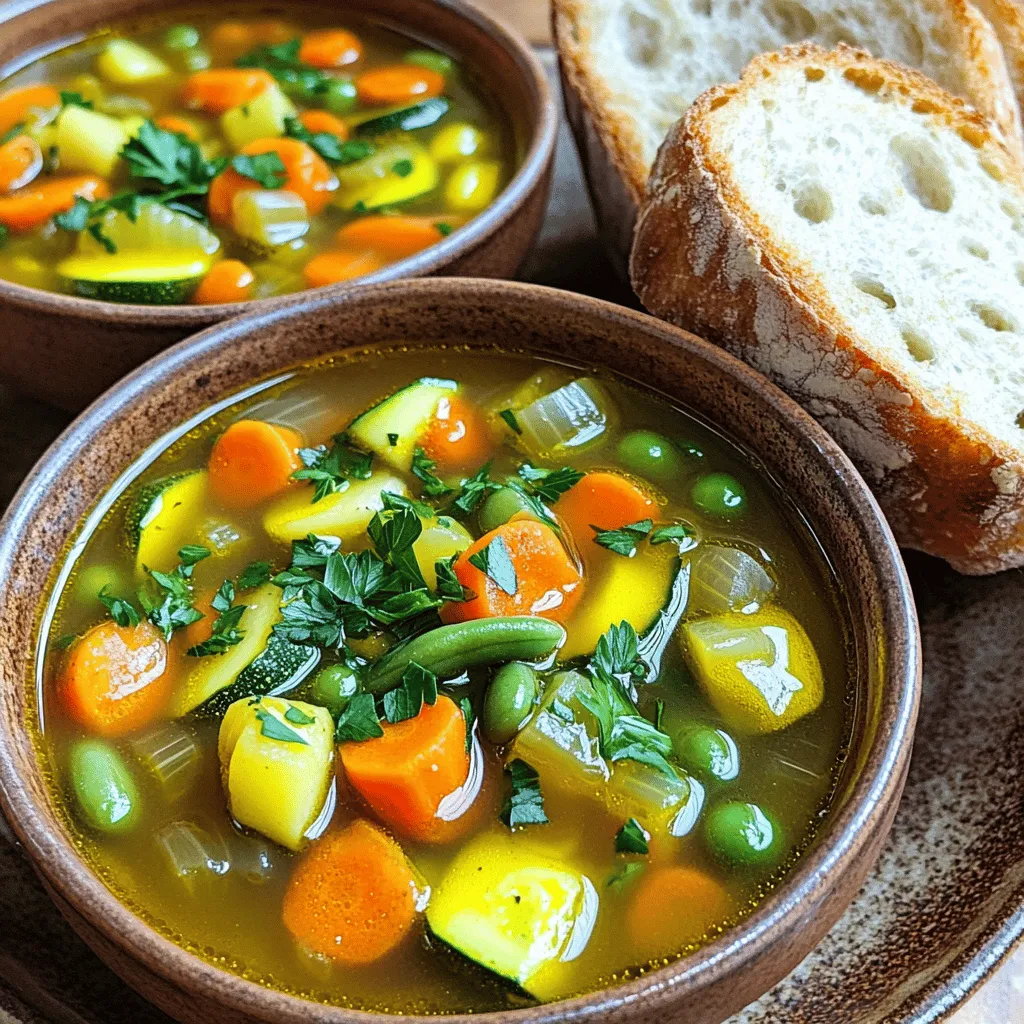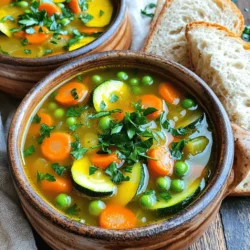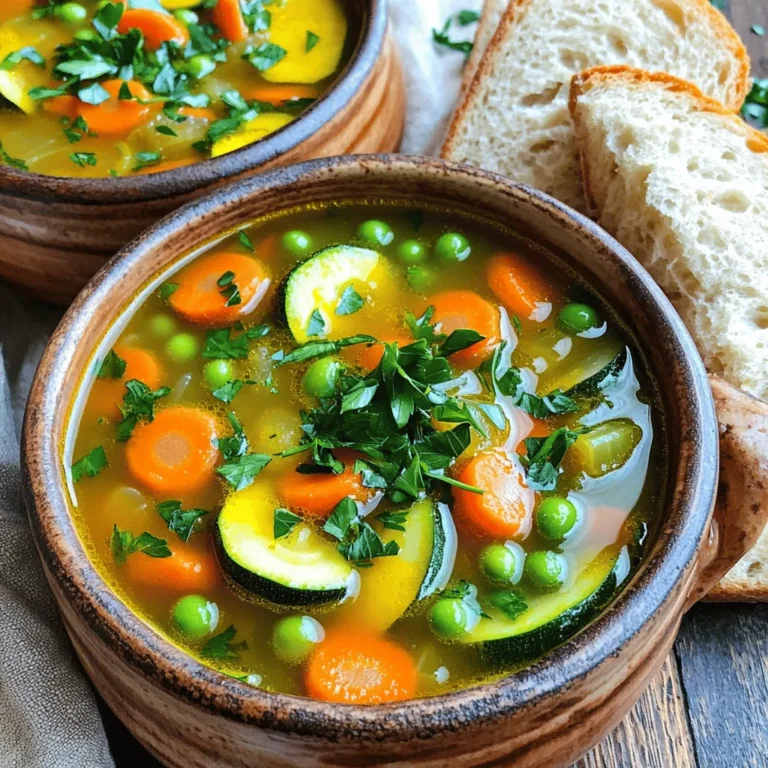Do you crave a bowl of warmth and comfort? My Classic Vegetable Soup recipe is just what you need! Packed with fresh veggies and simple spices, this dish is hearty and nourishing. It’s perfect for any season, easy to make, and full of flavor. Let’s dive into a delightful cooking adventure that will feed your body and soul! You’ll love how simple it is to create a homemade classic.
Ingredients
List of Ingredients
– 2 tablespoons extra virgin olive oil
– 1 medium onion, finely diced
– 2 cloves garlic, finely minced
– 2 medium carrots, peeled and diced
– 2 celery stalks, finely diced
– 1 medium potato, peeled and diced into small cubes
– 1 medium zucchini, diced
– 1 cup fresh green beans, trimmed and cut into 1-inch segments
– 1 can (14 oz) diced tomatoes, with their juices included
– 4 cups low-sodium vegetable broth
– 1 teaspoon dried thyme
– 1 teaspoon dried basil
– 1 bay leaf
– Sea salt and freshly cracked black pepper, to taste
– Fresh parsley, finely chopped (for garnish)
Gathering fresh ingredients is key for a great soup. I love using bright carrots, crunchy celery, and sweet onions. These veggies add depth and texture. Fresh herbs like thyme and basil enhance the flavor. The broth ties everything together, making the soup rich and warm.
Use good-quality olive oil for sautéing. It adds flavor and richness. You can adjust the vegetables based on what you have. Feel free to add peas, corn, or any favorite veggies. The goal is to make it your own.
For garnish, fresh parsley brightens up the dish. It adds a pop of color and freshness. Remember, this soup is all about the veggies and the joy of cooking.
Step-by-Step Instructions
Preparation Steps
1. Heating the oil and sautéing the onions
Start by heating 2 tablespoons of extra virgin olive oil in a large soup pot over medium heat. Once the oil is hot, add 1 medium onion, finely diced. Sauté the onion for about 3-4 minutes until it turns translucent and fragrant.
2. Adding garlic and initial vegetables
Next, add 2 cloves of minced garlic to the pot. Cook for 1 minute, stirring often. Then, introduce 2 medium carrots, peeled and diced, along with 2 finely diced celery stalks. Cook these vegetables for around 5 minutes until they soften and release their aroma.
3. Introducing remaining ingredients
Now, it’s time to add 1 medium potato, peeled and diced into small cubes. Add 1 medium zucchini, diced, and 1 cup of fresh green beans, cut into 1-inch segments. Stir until everything combines well. Pour in 1 can of diced tomatoes (14 oz), along with 4 cups of low-sodium vegetable broth. Sprinkle in 1 teaspoon each of dried thyme and dried basil, plus 1 bay leaf. Stir the pot to mix everything.
Cooking Process
1. Bringing to a boil and simmering
Increase the heat to bring the soup to a gentle boil. Once it starts to boil, reduce the heat to low. Allow the soup to simmer uncovered for about 25-30 minutes. This lets the vegetables become tender and the flavors blend beautifully.
2. Final seasoning adjustments
After simmering, taste your soup. Season it with sea salt and freshly cracked black pepper to your liking. Don’t forget to remove the bay leaf before serving.
Serving Suggestions
1. Ladling into bowls and garnishing
Serve the soup hot by ladling it into bowls. For a nice touch, garnish each bowl with finely chopped fresh parsley. This adds color and flavor.
2. Pairing with bread or additional sides
Pair your soup with slices of crusty bread. This bread is perfect for dipping into the hearty broth. Enjoy the comforting warmth of your classic vegetable soup!
Tips & Tricks
Flavor Enhancements
To boost flavor, always start with fresh ingredients. Fresh herbs add bright notes. If you use dried herbs, add them early in the cooking. This gives them time to release their flavors. For best results, use about one-third the amount of dried herbs compared to fresh. Fresh herbs should be added at the end to keep their taste vibrant.
Cooking Techniques
Vegetable size matters. Cut them into even pieces for even cooking. This helps them cook at the same rate. Larger chunks take longer, while smaller ones cook faster. To avoid overcooking, keep an eye on the simmer. Cook until vegetables are tender but still firm. Taste along the way to find the perfect texture.
Dietary Adjustments
This soup is easy to adapt. To make it vegan, skip any animal-based broths. Use vegetable broth, which is already in the recipe. For gluten-free options, ensure your broth is gluten-free. Add protein with beans or lentils. They make the soup heartier and more filling. Adding a can of chickpeas or cooked lentils can make it a complete meal.

Variations
Seasonal Ingredients
You can switch the vegetables in this soup based on the season. In spring, try using fresh peas or asparagus. In summer, add corn or bell peppers for a sweet crunch. For fall, root vegetables like squash fit perfectly. In winter, hearty greens like kale add warmth and nutrition.
Adding beans or legumes makes the soup more filling. Chickpeas, lentils, or black beans are great choices. They boost protein and fiber. You can mix and match based on what you have.
International Twists
Adding spices gives your soup a global flair. For a spicy kick, try cumin or chili powder. If you want something more fragrant, add ginger or turmeric. These spices transform the soup into a new dish each time.
Different cultures have their own versions of vegetable soup. For example, Italian minestrone includes pasta and pesto. In Thai cuisine, you might find coconut milk and lemongrass. Exploring these variations keeps your cooking exciting.
Creamy Versions
To make your soup creamy, you can use dairy or dairy-free options. Heavy cream adds richness. If you prefer a lighter touch, try coconut milk or cashew cream. These options also keep it vegan.
Blending part of the soup is key for creaminess. Use an immersion blender or regular blender. Blend until smooth, then mix it back in with the chunky parts. This creates a nice texture while keeping the flavors intact.
Storage Info
Refrigeration
To store leftover soup in the fridge, let it cool first. Transfer the soup to a container with a lid. I recommend using glass or BPA-free plastic containers. These help keep the soup fresh and tasty. Store the soup in the fridge for up to three days.
Freezing
If you want to freeze the soup, let it cool completely. Pour the soup into freezer-safe containers or bags. Leave some space at the top, as soup expands when frozen. Label the bags with the date. Thaw the soup in the fridge overnight when you are ready to eat. To reheat, warm it on the stove over medium heat or in the microwave until hot.
Shelf Life
When stored properly, your soup will last about three days in the fridge. In the freezer, it can last up to three months. Always check for signs of spoilage before eating. Look for changes in color, texture, or smell. If it seems off, it’s best to throw it away. Enjoy your hearty comfort vegetable soup knowing you can savor it later!
FAQs
How do you make classic vegetable soup?
To make classic vegetable soup, follow these steps:
1. Heat 2 tablespoons of extra virgin olive oil in a large pot over medium heat.
2. Add 1 finely diced onion and sauté for 3-4 minutes until it turns translucent.
3. Stir in 2 finely minced garlic cloves and cook for 1 minute.
4. Add 2 diced carrots and 2 diced celery stalks, cooking for about 5 minutes.
5. Mix in 1 diced potato, 1 diced zucchini, and 1 cup of green beans cut into 1-inch pieces.
6. Pour in 1 can of diced tomatoes (14 oz) and 4 cups of low-sodium vegetable broth.
7. Sprinkle in 1 teaspoon of dried thyme, 1 teaspoon of dried basil, and add 1 bay leaf.
8. Bring the soup to a gentle boil, then reduce the heat and let it simmer for 25-30 minutes.
9. Season with sea salt and black pepper to taste before serving. Remove the bay leaf.
10. Ladle into bowls and garnish with fresh parsley.
Can I use frozen vegetables?
Yes, you can use frozen vegetables for this soup. They are a great time-saver!
– Best practices:
– Thaw the vegetables before adding them to the soup.
– You might need to adjust cooking times since frozen veggies are pre-cooked.
– Fresh vegetables often have better flavor, but frozen can work well in a pinch.
What’s the best way to customize vegetable soup?
You can easily customize vegetable soup to match your tastes!
– Tips for personalization:
– Add your favorite vegetables, like spinach or bell peppers.
– Use different herbs and spices to change the flavor.
– Mix in cooked grains like rice or quinoa for extra heartiness.
– Don’t forget to adjust salt and pepper to suit your palate.
What broth is best for vegetable soup?
For the best flavor, use low-sodium vegetable broth.
– Recommendations:
– Look for brands with natural ingredients.
– You can also make your own broth with leftover vegetable scraps.
– Avoid high-sodium broths to keep your soup healthy.
This blog post covered how to make a tasty vegetable soup. We discussed the key ingredients, preparation, cooking methods, and serving ideas. You learned tips on enhancing flavor and adjusting the recipe for dietary needs. Variations let you explore seasonal and international flavors. Plus, we shared storage tips for leftovers.
In closing, soup is easy, fun, and perfect for everyone. Experiment with what you love and enjoy!


